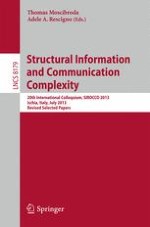This book constitutes the thoroughly refereed post-conference proceedings of the 20th International Colloquium on Structural Information and Communication Complexity, SIROCCO 2013, held in Ischia, Italy, in July 2013. The 28 revised full papers presented were carefully reviewed and selected from 67 submissions. SIROCCO is devoted to the study of communication and knowledge in distributed systems. Special emphasis is given to innovative approaches and fundamental understanding, in addition to efforts to optimize current designs. The typical areas include distributed computing, communication networks, game theory, parallel computing, social networks, mobile computing (including autonomous robots), peer to peer systems, communication complexity, fault tolerant graph theories and randomized/probabilistic issues in networks.
